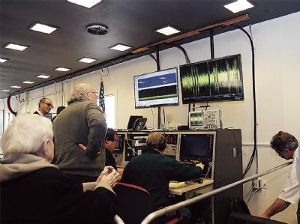
Project Diana’s 70th anniversary was marked at Camp Evans
By Christopher Neely
WALL TOWNSHIP – When a team of scientists in Wall Township sent a radio signal from Camp Evans to the moon on Jan. 10, 1946, it marked an important step in human civilization’s quest for space exploration.
It was on that day that the world learned communication with an extraterrestrial object was, in fact, possible, and suddenly the doors were thrust open to a myriad of possibilities, which were previously only dreamt about in science fiction novels.
Last Sunday, Jan. 10, marked the 70th anniversary of Project Diana, and to recognize that pivotal moment, hordes of scientists, professors, students and interested spectators gathered at Camp Evans to recreate the momentous, astronomical success that was experienced in that building seven decades ago.
Over 60 people, including Wall Township Mayor Ann Marie Conte, Committeeman Dominick DiRocco, Monmouth County Sheriff Shaun Golden, other local dignitaries and members of the public watched in awe as officials from the Ocean Monmouth Amateur Radio Club [OMARC], Princeton University and Info Age spoke in detail about the project’s process, its importance to the advancement of astronomy and space exploration, and prepared a real-life simulation of radio communication with the moon.
According to Jeff Harshman, OMARC’s president, the event was at the “pinnacle” of events hosted at Camp Evans.
“Project Diana was largely considered the first shot fired in the ‘space race’,” Mr. Harshman said. “It proved that we could send something into outer space and communicate with it.”
Conducted right after WWII by the United States Army Signal Corps, the project was named after the Roman Goddess of the Moon, “Diana.” On that day, 70 years ago, a team, under the command of Lt. Col. John Dewitt and astrophysicist Dr. William McAfee, prepared to send out another round of radio signals at 111.5 MHz after a few previously failed attempts.
At 11:58 a.m., a resounding beep rang through the lab, indicating the signal was sent out. After a long 2.5 seconds, a second, lower beep filled the room. Although the second beep was quieter, it would be heard around the world, as it confirmed Project Diana’s success.
An artificial radio signal just took a 477,000-mile round trip to the moon and back. Terrestrial humans successfully communicated with an extraterrestrial object for the first time; it marked an important step in the progression of astronomy.
The event was the first demonstration that radio signals could penetrate all layers of the Earth’s atmosphere and it was the official birth of radar astronomy, which has since been used to map out nearby planets, such as Venus, and communicate with satellites and spacecrafts. The obsession with naming space projects after gods in Roman and Greek mythology, such as Mercury and Apollo, also had its genesis here.
According to the Camp Evans website’s description of the event, “Just as Hiroshima opened up the nuclear age, Project Diana opened up the Space Age.”
On Sunday, as the time approached 11:58 a.m., Dan Marlow, a physics professor at Princeton University, addressed the enthusiastic crowd with an explanation of what they were about to witness.
When the clock struck 11:58 a.m., Mr. Marlow pressed the trigger that resulted in seven beeps, seven shots of radio signal. And mirroring the moment from seven decades ago, 2.5 seconds later, the seven beeps were returned to a room full of palpable excitement and audible applause.
Mr. Harshman said the event was coordinated with amateur radio stations in Europe. The stations in Europe and Camp Evans aimed their satellite dishes at the perfect angle toward the moon. One station would shoot Morse Code radio signals from their dish, the signals would hit the moon at a perfect angle and reflect back to the satellite dish in Europe.
The stations were communicating with each other throughout the day by casually bouncing radio signals off the Moon.
The stars seemed to align on Sunday, or at least the moon and Earth did, as the day’s conditions made the moon available for radio contact for a majority of the event, which allowed a once-in-a-lifetime opportunity for spectators to test out the equipment and participate in making EME communications [Earth-Moon-Earth].
In the 70 years since that historic day in Wall Township, Earth has been able to launch and operate satellites, send humans to the moon, put rovers on Mars and build an International Space Station.
While it may be unlikely that the responsible scientists considered those possibilities seven decades ago, what happened at Camp Evans on Jan. 10, 1946 unlocked their potential